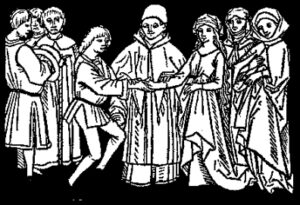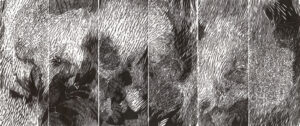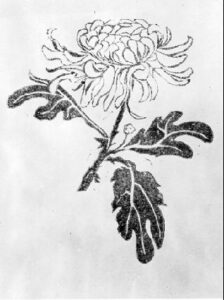The “Sleeping Beauty Problem” yields two competing solutions to a seemingly elementary question: What is the probability of a coin toss landing heads? Most people, including Patrick Hawley, would say, “1/2!” but Adam Elgar replies differently; in the case of the “Sleeping Beauty Problem”: “1/3.” In this scenario, the subject, Beauty, is put to sleep on Sunday, and then a fair coin is tossed. If the coin toss yields heads, then Beauty is awakened on Monday and Wednesday. If the toss yields tails, Beauty will instead be awakened on Monday, Tuesday, and Wednesday. Throughout the duration of the experiment, Beauty is injected with a drug that removes memories of being awakened; thus, if she is awakened on Tuesday, she will not remember Monday’s disturbance. Thus, Elga’s answer of 1/3 heads is his response to a more complex version of the elementary question: “When the subject is awakened on Monday, to what degree will she believe that the outcome of the coin toss is heads?” Elga, a “thirder,” interestingly—but incorrectly—believes that the probabilities of being awakened on Monday with heads, Monday with tails, and Tuesday with tails are equal. Patrick Hawley, a “halfer,” refutes Elga’s argument, instead correctly stating that the answer to the problem is 1/2, since the probability of Beauty waking up on Monday is “1,” rather than less than “1” as Elga states. Although Elga and Hawley create similar analyses at points, Hawley is ultimately correct in saying that the halfer’s conclusion possesses more merit than the thirder’s.
Elga incorrectly believes that the answer to the Sleeping Beauty problem is 1/3 heads and 2/3 tails, rather than 1/2 heads and 1/2 tails. To explain his reasoning, he first presents three “waking” possibilities: “H1: Heads on Monday,” “T1: Tails on Monday,” and “T2: Tails on Tuesday.” ((Adam Elga, “Self-locating Belief and the Sleeping Beauty Problem,” Analysis 60 (2000): 144.)) He states that if the researchers wake up Beauty and tell her it is Monday, she is living either the H1 or T1  circumstance; thus, H1 and T1 both have a probability of 1/2. If Beauty wakes up on either Monday or Tuesday and learns that the coin landed on tails, she is in either T1 or T2; therefore, T1 and T2 both have a probability of 1/2. ((Elga, “Self-locating Belief,” 145.)) Essentially, if H1 = T1 and T1 = T2, then, according to Elga’s “highly restrictive indifference principle,” H1 must equal T2. ((Elga, “Self-locating Belief,” 145.)) Therefore, H1 = T1 = T2. The likelihood of each waking must be 1/3, since they must yield a sum of 1. He also illustrates that Beauty’s thoughts should change from Sunday to Monday. ((Elga, “Self-locating Belief,” 145.)) On Sunday, she should believe indisputably that there is a 50% chance of heads and a 50% chance of tails, considering the coin is fair. Yet, when she is awakened on Monday, she should have confidence that there is a 1/3 chance each of H1, T1, and T2. ((Elga, “Self-locating Belief,” 145.)) Elga attributes the change in credence to the fact that when she wakes up on Monday, she considers her “temporal location as relevant to H,” in contrast to Sunday, when her temporal location was not relevant. If she is not told explicitly that it is Monday, she is aware that her place in time is somewhere in the midst of the experiment. According to Elga, this is relevant information that should cause her belief to change from a 1/2 chance of heads or tails on Sunday to a 1/3 chance of heads, and a 2/3 chance of tails on Monday.
circumstance; thus, H1 and T1 both have a probability of 1/2. If Beauty wakes up on either Monday or Tuesday and learns that the coin landed on tails, she is in either T1 or T2; therefore, T1 and T2 both have a probability of 1/2. ((Elga, “Self-locating Belief,” 145.)) Essentially, if H1 = T1 and T1 = T2, then, according to Elga’s “highly restrictive indifference principle,” H1 must equal T2. ((Elga, “Self-locating Belief,” 145.)) Therefore, H1 = T1 = T2. The likelihood of each waking must be 1/3, since they must yield a sum of 1. He also illustrates that Beauty’s thoughts should change from Sunday to Monday. ((Elga, “Self-locating Belief,” 145.)) On Sunday, she should believe indisputably that there is a 50% chance of heads and a 50% chance of tails, considering the coin is fair. Yet, when she is awakened on Monday, she should have confidence that there is a 1/3 chance each of H1, T1, and T2. ((Elga, “Self-locating Belief,” 145.)) Elga attributes the change in credence to the fact that when she wakes up on Monday, she considers her “temporal location as relevant to H,” in contrast to Sunday, when her temporal location was not relevant. If she is not told explicitly that it is Monday, she is aware that her place in time is somewhere in the midst of the experiment. According to Elga, this is relevant information that should cause her belief to change from a 1/2 chance of heads or tails on Sunday to a 1/3 chance of heads, and a 2/3 chance of tails on Monday.
Although he acknowledges that Elga’s argument has its strengths, Patrick Hawley rightfully unveils the clear flaws in the thirder’s beliefs, and reasons that 1/2 is indeed the correct solution. Hawley and other halfers, including David Lewis, agree with Elga on the Principal Principle, which states that Beauty should accept the answer of 1/2 on Sunday because the coin was fair, meaning that there is an equal chance of heads or tails. ((Patrick Hawley, “Inertia, Optimism, and Beauty,” Phil-Sci Archive 10 March 2010, 8.)) Hawley also agrees with Elga that the probability of H1 is equal to T1. ((Hawley, “Inertia,” 8.)) Agreement ends, however, with Elga’s conclusion that H1 = T2 and Beauty’s change of credence from 1/2 to 1/3. This is first because Elga’s conclusions are incompatible with the property of inertia: “If you should have a degree of belief d that p at time t1, and between t1 and a later time t2, your cognitive facilities remain in order, and you neither gain nor lose relevant evidence, then you should also have degree of belief d that p at time t2.” ((Hawley, “Inertia,” 2.)) In other words, if one believes something and does not gain or lose evidence regarding that belief, then they should continue their belief to the same degree. Since Beauty is asleep between Sunday and Monday, she does not have the capability to learn anything. She only knows that regardless of the outcome of the coin toss, she will wake up on Monday. Thus, Beauty’s certainty of 1/2 should not change. According to the property of inertia, if Elga argues that her credence is 1/2 on Sunday, it should remain 1/2 on Monday.
According to Elga, Beauty’s temporal location changes from irrelevant to relevant during the period from Sunday to Monday because her awareness of this change is new evidence. Therefore, the property of inertia would not be application because something has changed between Sunday and Monday. Hawley, however, believes he and other thirders do not provide enough explanation to support such a claim of “new evidence.” Elga states that Beauty’s awareness of a change of temporal location is relevant because it causes her to modify her credence from Sunday to Monday, but he does not say why this is the case. Hawley points out that on Sunday, Beauty was aware that her temporal location would change in the future. So, why would Beauty not take that into consideration on Sunday before she feel asleep? Elga and other thirders do not acknowledge this question. Since this is a significant flaw that goes unaddressed, the merit of the thirders’ argument diminishes. Hawley believes that their lack of explanation is the reason that arguments regarding the Sleeping Beauty Problem persist. ((Hawley, “Inertia,” 3.)) Thirders like Elga are still trying to invent reasons that the change of temporal location is relevant evidence. Yet, no one has truly succeeded in proving that the change in temporal location matters. Instead, the correct answer is that the change of temporal location simply isn’t relevant. Beauty knew on Sunday that she would wake up at another time; she knew ahead of time that her temporal location would change. The only real evidence Beauty has upon waking up is her memory of Sunday. Since nothing changes between Sunday and Monday, her credence should not change either.
Hawley also provides a convincing rebuttal to Elga’s paper by posing a question: “When Beauty wakes up on Monday, what should her degree of belief be that it is Monday?” ((Hawley, “Inertia,” 5.)) The thirders assume that Beauty must be uncertain of whether it is Monday or Tuesday. Their argument relies on this “unquestioned assumption” because they assume Beauty cannot know for sure if she is in H1, T1 or T2. ((Hawley, “Inertia,” 5.)) Hawley, however, rejects the assumption that Beauty is always unsure of whether it is Monday or Tuesday because the assumption is formulated merely due to intuition rather than reasoning. ((Hawley, “Inertia,” 5.)) Strong reasoning should prevail over intuition since our intuition is not always reliable in situations as complex as the Sleeping Beauty scenario. In other words, our intuitive thinking is likely to be refuted by critical reason. Thus, the unquestioned assumption should be questioned. To answer his own question, Hawley states that Beauty should have credence of 1 in terms of the probability that it is Monday because the probability of heads on Monday is 1/2, and the probability of heads overall is 1/2. ((Hawley, “Inertia,” 15.)) If the coin lands on heads, she will never be wrong about what day it is. ((Hawley, “Inertia,” 6.)) Hawley terms her faith on Monday the “optimistic policy,” which is counter-intuitive because most would immediately reply that there is actually a chance that it is Tuesday. ((Hawley, “Inertia, ” 5.)) Inertia must be recalled in order to provide careful reasoning to replace impulsive beliefs. Upon waking, Beauty understands that she has not gained or lost any new information. Again, she cannot rationally accept, under the property of inertia, that it is Tuesday because there is no evidence suggesting that Monday has already passed. Elga is incorrect in claiming that there is an equal chance of H1, T1, and T2 occurring because the property of inertia states that she has no reason to believe in T2.
By countering the thirders’ arguments, Hawley has paved the way for the correct conclusion: the answer to the Sleeping Beauty Problem is, in fact, the same as the age-old answer to the probability of each outcome of a fair coin toss: 1/2. There are only heads and tails.
It is quite true that if Beauty upholds the optimistic policy she will be wrong when she awakens on Tuesday. For this reason, thirders are attracted to the thought of uncertainty of the day. Since she does not know whether it is Monday or Tuesday, she should give at least some probability to T2, or Tuesday. ((Hawley, “Inertia,” 25.)) Yet, the optimistic policy rejects this claim, finding instead that because Beauty is completely positive that she is awake, and has no evidence other than Sunday, she should be certain that it is Monday. ((Hawley, “Inertia,” 25.)) She has no reason to believe that it is Tuesday because she has learned nothing new; her past memories are from Sunday, and she does not remember being awakened on Monday. ((Hawley, “Inertia,” 26.)) Although this is a difficult principle to uphold and is certainly counter-intuitive, it is correct because it is compatible with the property of inertia. Since nothing was gained or lost, her credence should not change. Therefore, the rational choice would be to believe that it is Monday. If it is Monday, then there are two choices: Beauty is living either in H1 or T1. To clarify, the coin has landed on heads or tails; in both cases, the day is Monday. There is a 50/50 chance of each situation occurring. Therefore, the answer to the Sleeping Beauty Problem is 1/2 and not 1/3.
In response to Hawley, Elga would undoubtedly encounter problems. First, he would acknowledge the truth behind the property of inertia, but claim that it is not applicable to the situation, since Beauty realizes hat she is in a new point in time, which is relevant to her changing her credence from 1/2 to 1/3 on Monday. To this, Hawley would again pose the question: “Why would Beauty not take this into consideration on Sunday, since she knows she will wake up on Monday?” Since Beauty is aware that she will wake up on Monday and does not jettison that awareness at any point during the experiment, her thoughts have no reason to change. Elga fails to respond to this critical question with a worthy explanation, which gives Hawley the upper hand for this part of the argument. Elga would also reject Hawley’s ultimate conclusion that Beauty should have full belief that it is Monday. Instead, he would take a skeptical view, saying that Beauty cannot be completely sure that it is Monday versus Tuesday, since the injected drug erases all memories of previous awakenings; she would know that she had awakened on Monday if she wakes up on Tuesday. He would insist that the probability of Monday should be less than 1 because she needs to take T2 into account. Hawley acknowledges this. Yet, since Beauty has no evidence to believe that she has awakened after Sunday, she should believe that it is Monday. Due to the property of inertia, the lack of new (or lost) evidence means that she should stand by the belief that she will be awakened next on Monday, and that the probability is 1/2 heads and 1/2 tails. She has no evidence to support a prior awakening on Monday; therefore, she has no concrete or rational reason to say that it is Tuesday unless someone tells her it is.
Both Elga and Hawley present convincing arguments; however, it is Hawley who persists here because he points out the flaws in the thirders’ argument and provides his own reasoning for the 1/2 solution. The thirder argument fails to provide evidence for the change in temporal location as relevant evidence, whereas the halfer effectively refutes this by pointing out the applicability of the property of inertia. The thirder argument relies on skepticism of Monday versus Tuesday, yet halfers convincingly introduce the lack of evidence to prove that Monday has passed. Therefore, Beauty must have full credence on Monday and believe that she is in either H1 or T1; there is a 1/2 chance of both outcomes. By countering the thirders’ arguments, Hawley has paved the way for the correct conclusion: the answer to the Sleeping Beauty Problem is, in fact, the same as the age-old answer to the probability of each outcome of a fair coin toss: 1/2. There are only heads and tails.
Bibliography
Elga, Adam. “Self-locating Belief and the Sleeping Beauty Problem.” Analysis 60 (2000): 143-147.
Hawley, Patrick. “Inertia, Optimism, and Beauty.” PhilSci Archive 10 March 2010. http://philsci-archive.pitt.edu/5319/1/iob.pdf (Accessed October 26 2011).












